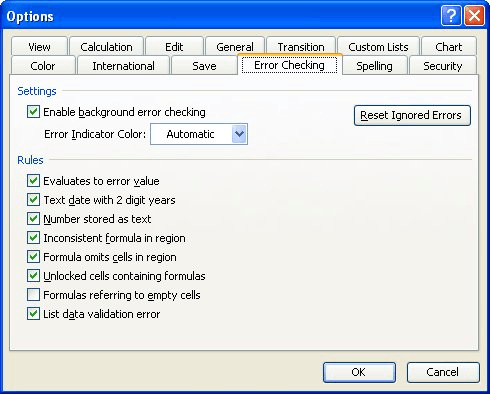Please Note: This article is written for users of the following Microsoft Excel versions: 2002 and 2003. If you are using a later version (Excel 2007 or later), this tip may not work for you. For a version of this tip written specifically for later versions of Excel, click here: Changing Error Checking Rules.
When Excel 2002 or Excel 2003 does background checking of your worksheet for errors, it follows a set number of rules. You can modify the rules that Excel follows through these steps:

Figure 1. The Error Checking tab of the Options dialog box.
ExcelTips is your source for cost-effective Microsoft Excel training. This tip (2370) applies to Microsoft Excel 2002 and 2003. You can find a version of this tip for the ribbon interface of Excel (Excel 2007 and later) here: Changing Error Checking Rules.

Excel Smarts for Beginners! Featuring the friendly and trusted For Dummies style, this popular guide shows beginners how to get up and running with Excel while also helping more experienced users get comfortable with the newest features. Check out Excel 2019 For Dummies today!
You can freeze information in rows or columns using one of the built-in features of Excel. As you move up or down in the ...
Discover MoreYou may want to have all your Excel workbooks stored in a specific location on your system. Here's how to set the default ...
Discover MoreWant to use the maximum space possible for displaying information on screen? You'll want to learn how to use the ...
Discover MoreFREE SERVICE: Get tips like this every week in ExcelTips, a free productivity newsletter. Enter your address and click "Subscribe."
There are currently no comments for this tip. (Be the first to leave your comment—just use the simple form above!)
Got a version of Excel that uses the menu interface (Excel 97, Excel 2000, Excel 2002, or Excel 2003)? This site is for you! If you use a later version of Excel, visit our ExcelTips site focusing on the ribbon interface.
FREE SERVICE: Get tips like this every week in ExcelTips, a free productivity newsletter. Enter your address and click "Subscribe."
Copyright © 2026 Sharon Parq Associates, Inc.
Comments